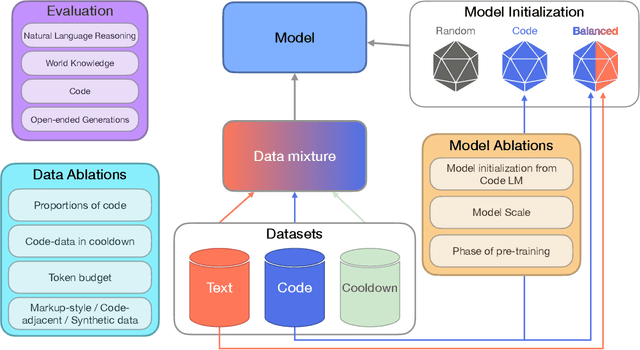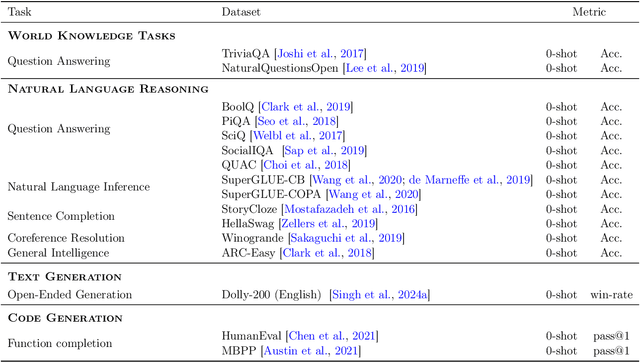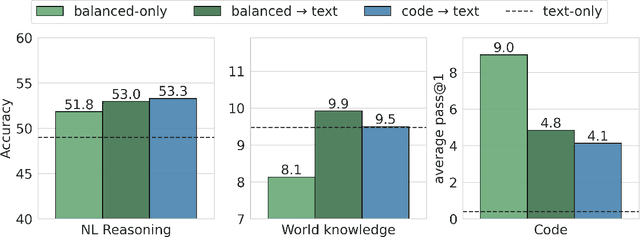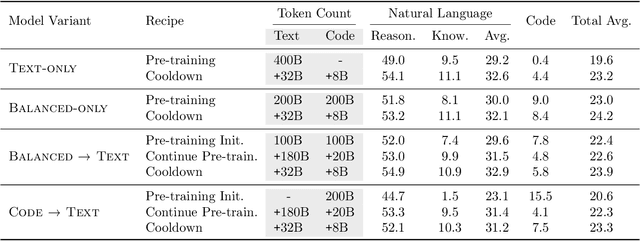Ivan Zhang
Command A: An Enterprise-Ready Large Language Model
Apr 01, 2025Abstract:In this report we describe the development of Command A, a powerful large language model purpose-built to excel at real-world enterprise use cases. Command A is an agent-optimised and multilingual-capable model, with support for 23 languages of global business, and a novel hybrid architecture balancing efficiency with top of the range performance. It offers best-in-class Retrieval Augmented Generation (RAG) capabilities with grounding and tool use to automate sophisticated business processes. These abilities are achieved through a decentralised training approach, including self-refinement algorithms and model merging techniques. We also include results for Command R7B which shares capability and architectural similarities to Command A. Weights for both models have been released for research purposes. This technical report details our original training pipeline and presents an extensive evaluation of our models across a suite of enterprise-relevant tasks and public benchmarks, demonstrating excellent performance and efficiency.
Aya Expanse: Combining Research Breakthroughs for a New Multilingual Frontier
Dec 05, 2024



Abstract:We introduce the Aya Expanse model family, a new generation of 8B and 32B parameter multilingual language models, aiming to address the critical challenge of developing highly performant multilingual models that match or surpass the capabilities of monolingual models. By leveraging several years of research at Cohere For AI and Cohere, including advancements in data arbitrage, multilingual preference training, and model merging, Aya Expanse sets a new state-of-the-art in multilingual performance. Our evaluations on the Arena-Hard-Auto dataset, translated into 23 languages, demonstrate that Aya Expanse 8B and 32B outperform leading open-weight models in their respective parameter classes, including Gemma 2, Qwen 2.5, and Llama 3.1, achieving up to a 76.6% win-rate. Notably, Aya Expanse 32B outperforms Llama 3.1 70B, a model with twice as many parameters, achieving a 54.0% win-rate. In this short technical report, we present extended evaluation results for the Aya Expanse model family and release their open-weights, together with a new multilingual evaluation dataset m-ArenaHard.
To Code, or Not To Code? Exploring Impact of Code in Pre-training
Aug 20, 2024



Abstract:Including code in the pre-training data mixture, even for models not specifically designed for code, has become a common practice in LLMs pre-training. While there has been anecdotal consensus among practitioners that code data plays a vital role in general LLMs' performance, there is only limited work analyzing the precise impact of code on non-code tasks. In this work, we systematically investigate the impact of code data on general performance. We ask "what is the impact of code data used in pre-training on a large variety of downstream tasks beyond code generation". We conduct extensive ablations and evaluate across a broad range of natural language reasoning tasks, world knowledge tasks, code benchmarks, and LLM-as-a-judge win-rates for models with sizes ranging from 470M to 2.8B parameters. Across settings, we find a consistent results that code is a critical building block for generalization far beyond coding tasks and improvements to code quality have an outsized impact across all tasks. In particular, compared to text-only pre-training, the addition of code results in up to relative increase of 8.2% in natural language (NL) reasoning, 4.2% in world knowledge, 6.6% improvement in generative win-rates, and a 12x boost in code performance respectively. Our work suggests investments in code quality and preserving code during pre-training have positive impacts.
Mitigating harm in language models with conditional-likelihood filtration
Sep 04, 2021



Abstract:Language models trained on large-scale unfiltered datasets curated from the open web acquire systemic biases, prejudices, and harmful views from their training data. We present a methodology for programmatically identifying and removing harmful text from web-scale datasets. A pretrained language model is used to calculate the log-likelihood of researcher-written trigger phrases conditioned on a specific document, which is used to identify and filter documents from the dataset. We demonstrate that models trained on this filtered dataset exhibit lower propensity to generate harmful text, with a marginal decrease in performance on standard language modeling benchmarks compared to unfiltered baselines. We provide a partial explanation for this performance gap by surfacing examples of hate speech and other undesirable content from standard language modeling benchmarks. Finally, we discuss the generalization of this method and how trigger phrases which reflect specific values can be used by researchers to build language models which are more closely aligned with their values.
Learning Sparse Networks Using Targeted Dropout
Jun 05, 2019



Abstract:Neural networks are easier to optimise when they have many more weights than are required for modelling the mapping from inputs to outputs. This suggests a two-stage learning procedure that first learns a large net and then prunes away connections or hidden units. But standard training does not necessarily encourage nets to be amenable to pruning. We introduce targeted dropout, a method for training a neural network so that it is robust to subsequent pruning. Before computing the gradients for each weight update, targeted dropout stochastically selects a set of units or weights to be dropped using a simple self-reinforcing sparsity criterion and then computes the gradients for the remaining weights. The resulting network is robust to post hoc pruning of weights or units that frequently occur in the dropped sets. The method improves upon more complicated sparsifying regularisers while being simple to implement and easy to tune.
Unsupervised Cipher Cracking Using Discrete GANs
Jan 15, 2018



Abstract:This work details CipherGAN, an architecture inspired by CycleGAN used for inferring the underlying cipher mapping given banks of unpaired ciphertext and plaintext. We demonstrate that CipherGAN is capable of cracking language data enciphered using shift and Vigenere ciphers to a high degree of fidelity and for vocabularies much larger than previously achieved. We present how CycleGAN can be made compatible with discrete data and train in a stable way. We then prove that the technique used in CipherGAN avoids the common problem of uninformative discrimination associated with GANs applied to discrete data.
 Add to Chrome
Add to Chrome Add to Firefox
Add to Firefox Add to Edge
Add to Edge